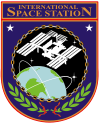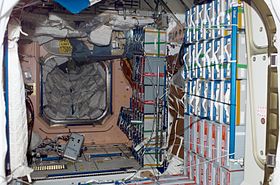- Unity (ISS module)
-
The Unity connecting module was the first U.S.-built component of the International Space Station. It is cylindrical in shape, with six berthing locations (forward, aft, port, starboard, zenith, and nadir) facilitating connections to other modules. Unity measures 4.57 metres (15.0 ft) in diameter, is 5.47 metres (17.9 ft) long, and was built for NASA by The Boeing Company in a manufacturing facility at the Marshall Space Flight Center in Huntsville, Alabama. Sometimes referred to as Node 1, Unity was the first of the three connecting modules; the other two are Harmony and Tranquility.
Contents
Launch and initial berthing
Unity was carried into orbit as the primary cargo of the Space Shuttle Endeavour on STS-88, the first Space Shuttle mission dedicated to assembly of the station. On December 6, 1998, the STS-88 crew mated the aft berthing port of Unity with the forward hatch of the already orbiting Zarya module. (Zarya was a mixed Russian-US funded and Russian-built component launched earlier aboard a Russian Proton rocket from Baikonur, Kazakhstan.) This was the first connection made between two station modules.
Connections to other station components
Unity has 2 axial, and 4 radial Common Berthing Mechanism (CBM) ports. In addition to connecting to the Zarya module, Unity currently connects to the U.S. Destiny Laboratory Module (added on STS-98), the Z1 truss (an early exterior framework for the station added on STS-92), the PMA-3 (also added on STS-92), and the Quest Joint Airlock (added on STS-104). In addition, the Leonardo and Raffaello Multi-Purpose Logistics Modules have each been berthed to Unity on multiple missions. During STS-120 the Harmony connecting module was temporarily berthed to the port-side hatch of Unity. Tranquility, with its multi-windowed cupola, was attached to Unity's port side during the STS-130 mission. However, recently NASA decided to leave the MPLM Leonardo permanently attached to the ISS, which as of STS-133 is located at the nadir side of Node 1.
Details
Essential space station resources such as fluids, environmental control and life support systems, electrical and data systems are routed through Unity to supply work and living areas of the station. More than 50,000 mechanical items, 216 lines to carry fluids and gases, and 121 internal and external electrical cables using six miles of wire were installed in the Unity node. Unity is made of aluminum.
Prior to its launch aboard Endeavour, conical Pressurized Mating Adapters (PMAs) were attached to the aft and forward berthing mechanisms of Unity. Unity and the two mating adapters together weighed about 25,600 pounds (11,600 kg). The adapters allow the docking systems used by the Space Shuttle and by Russian modules to attach to the node's hatches and berthing mechanisms. PMA-1 now permanently attaches Unity to Zarya, while PMA-2 provides a Shuttle docking port. Attached to the exterior of PMA-1 are computers, or multiplexer-demultiplexers (MDMs), which provided early command and control of Unity. Unity also is outfitted with an early communications system that allows data, voice and low data rate video with Mission Control, Houston, to supplement Russian communications systems during the early station assembly activities. PMA-3 was attached to Unity's nadir berthing mechanism by the crew of STS-92.
Other nodes
The two remaining station connecting modules, or nodes, were built in Italy by Alenia Aerospazio, as part of an agreement between NASA and the European Space Agency (ESA). Harmony (formerly known as Node 2) and Tranquility (formerly known as Node 3) are slightly longer than Unity, measuring almost 6.4 meters (21 ft) long. In addition to their six berthing ports, each can hold eight International Standard Payload Racks (ISPRs). Unity, in comparison, holds just four ISPRs. ESA built Nodes 2 and 3 as partial payment for the launch aboard the Shuttle of the Columbus laboratory module, and other ESA equipment.
Specifications
- Length: 5.49 m (18.0 ft)
- Diameter: 4.57 m (15.0 ft)
- Mass: 11,612 kg (25,600 lb)
References
- http://spaceflight.nasa.gov/spacenews/factsheets/pdfs/unity.pdf
- http://www.youtube.com/watch?v=lg1AYWifAeo filmed in July 2007 by Clayton Anderson
Components of the International Space Station Overview Assembly · US Orbital Segment · Russian Orbital Segment · Expeditions · Spacewalks · ISS Program · Scientific Research · Major Incidents
Major components
in orbitZarya (Functional Cargo Block) · Zvezda (Service Module) · Unity (Node 1) · Harmony (Node 2) · Tranquility (Node 3) · Destiny (Laboratory) · Columbus (Laboratory) · Kibō (PM, ELM-PS, EF) · Quest (Airlock) · Pirs (Airlock / Docking Module) · Rassvet (MRM 1) · Poisk (MRM 2) · Leonardo (PMM) · Cupola · Integrated Truss Structure (ITS)Subsystems
in orbitFlight-ready hardware
with no launch planScheduled for launch
by ProtonProposed module Cancelled Support vehicles Current: Soyuz · Progress · Automated Transfer Vehicle (ATV) · H-II Transfer Vehicle (HTV)
Future: Dragon · Cygnus · Orion · Rus · CST-100
Former: Space ShuttleMission control centers ← 1997 · Orbital launches in 1998 · 1999 → Lunar Prospector | Skynet 4D | Ofek-4 | STS-89 | Soyuz TM-27 | USA-137 | Brasilsat B3 · Inmarsat-3 F5 | Orbcomm FM3 · Orbcomm FM4 · GFO · Ad Astra | Globalstar 1 · Globalstar 2 · Globalstar 3 · Globalstar 4 | Kosmos 2349 | Iridium 50 · Iridium 52 · Iridium 53 · Iridium 54 · Iridium 56 | Kakehashi | SNOE · Teledesic 1 | Hot Bird 4 | Intelsat 806 | Progress M-38 (VDU-2) | USA-138 | SPOT 4 | Iridium 51 · Iridium 61 | Iridium 55 · Iridium 57 · Iridium 58 · Iridium 59 · Iridium 60 | TRACE | Iridium 62 · Iridium 63 · Iridium 64 · Iridium 65 · Iridium 66 · Iridium 67 · Iridium 68 | STS-90 | Globalstar 6 · Globalstar 8 · Globalstar 14 · Globalstar 15 | Nilesat 101 · BSat-1B | Kosmos 2350 | Iridium 69 · Iridium 71 | Kosmos 2351 | EchoStar IV | USA-139 | NOAA-15 | Progress M-39 | Iridium 70 · Iridium 72 · Iridium 73 · Iridium 74 · Iridium 75 | Zhongwei 1 | STS-91 | Thor 3 | Kosmos 2352 · Kosmos 2353 · Kosmos 2354 · Kosmos 2355 · Kosmos 2356 · Kosmos 2357 | Intelsat 805 | Kosmos 2358 | Kosmos 2359 | Molniya 3-49 | Nozomi | Shtil-1 · Tubsat-N · Tubsat-N1 | Resurs-O1 #4 · Fasat-Bravo · TMSAT · Gurwin Techsat 1B · WESTPAC · SAFIR-2 | Sinosat-1 | Kosmos 2360 | Orbcomm FM13 · Orbcomm FM14 · Orbcomm FM15 · Orbcomm FM16 · Orbcomm FM17 · Orbcomm FM18 · Orbcomm FM19 · Orbcomm FM20 | Mercury 3 | Soyuz TM-28 | Iridium 3 · Iridium 76 | ST-1 | Galaxy 10 | Astra 2A | Kwangmyŏngsŏng-1 | Iridium 77 · Iridium 79 · Iridium 80 · Iridium 81 · Iridium 82 | Globalstar 5 · Globalstar 7 · Globalstar 9 · Globalstar 10 · Globalstar 11 · Globalstar 12 · Globalstar 13 · Globalstar 16 · Globalstar 17 · Globalstar 18 · Globalstar 20 · Globalstar 21 | PAS-7 | Orbcomm FM21 · Orbcomm FM22 · Orbcomm FM23 · Orbcomm FM24 · Orbcomm FM25 · Orbcomm FM26 · Orbcomm FM27 · Orbcomm FM28 | Molniya-1T #99 | STEX (USA-141) | Eutelsat W2 · Sirius 3 | Hot Bird 5 | USA-140 | Maqsat 3 | Deep Space 1 · SEDSAT-1 | Progress M-40 (Sputnik 41) | AfriStar · GE-5 | STS-95 (SPARTAN-201 · PANSAT) | PAS-8 | Iridium 2 · Iridium 83 · Iridium 84 · Iridium 85 · Iridium 86 | Zarya | Bonum 1 | STS-88 (Unity · PMA-1 · PMA-2 · SAC-A · MightySat-1 | Satmex 5 | SWAS | Nadezhda 5 · Astrid 2 | Mars Climate Orbiter | Iridium 11 · Iridium 20 | PAS-6B | Kosmos 2361 | Kosmos 2362 · Kosmos 2363 · Kosmos 2364Payloads are separated by bullets ( · ), launches by pipes ( | ). Manned flights are indicated in bold text. Uncatalogued launch failures are listed in italics. Payloads deployed from other spacecraft are denoted in brackets.Categories:- Components of the International Space Station
- 1998 in spaceflight
Wikimedia Foundation. 2010.


